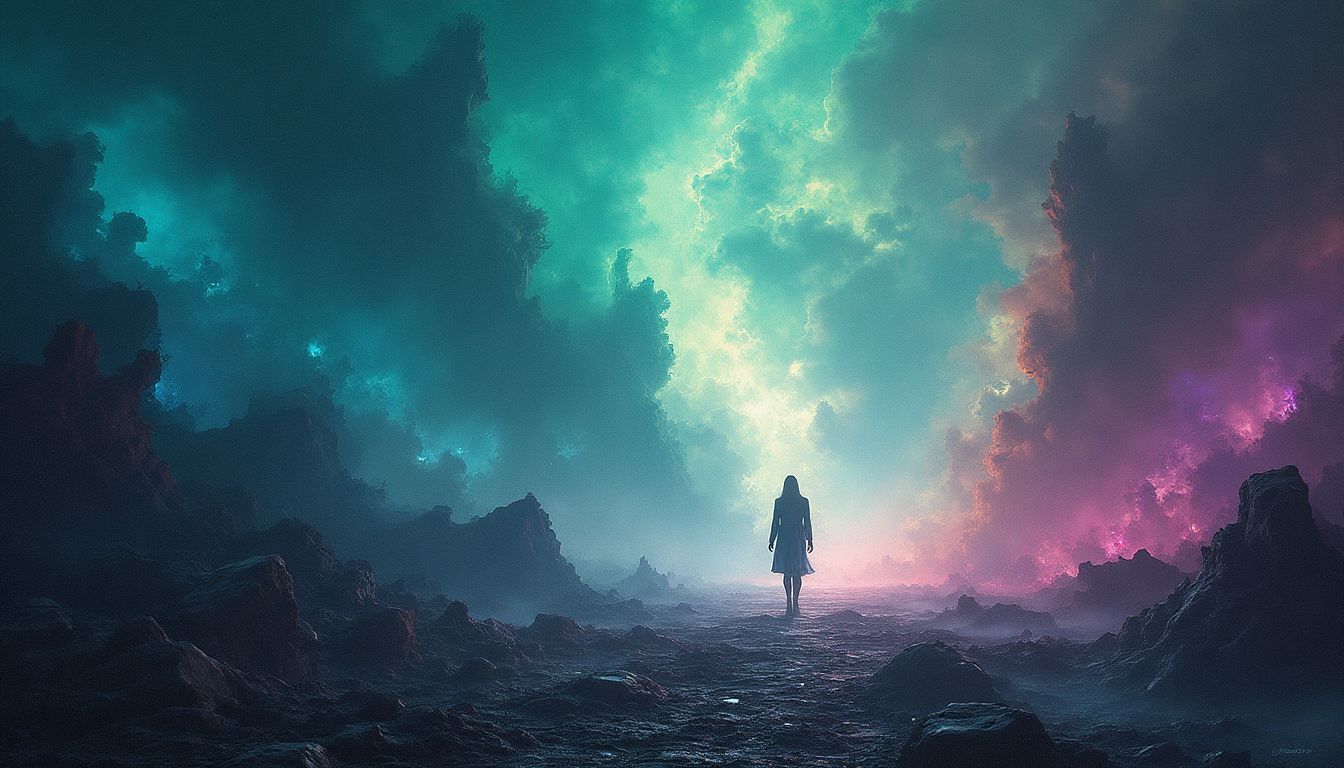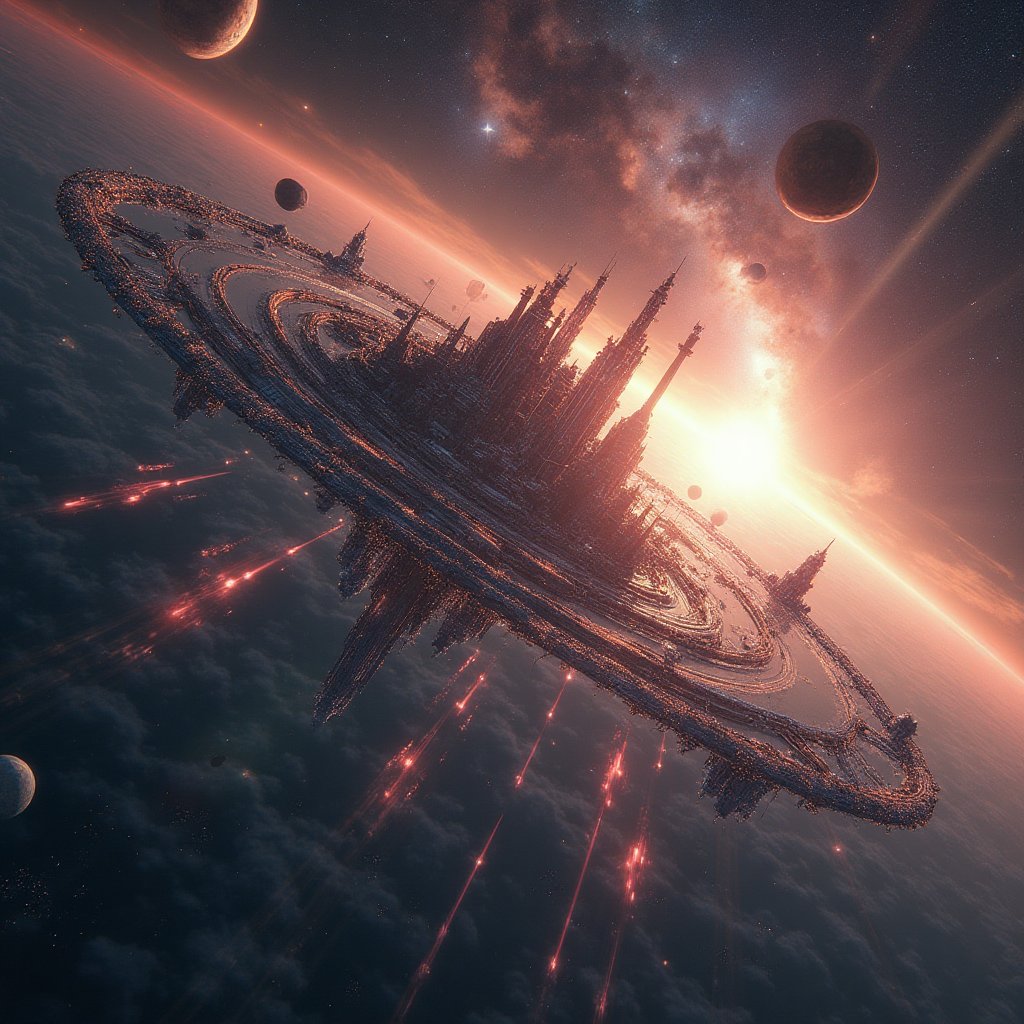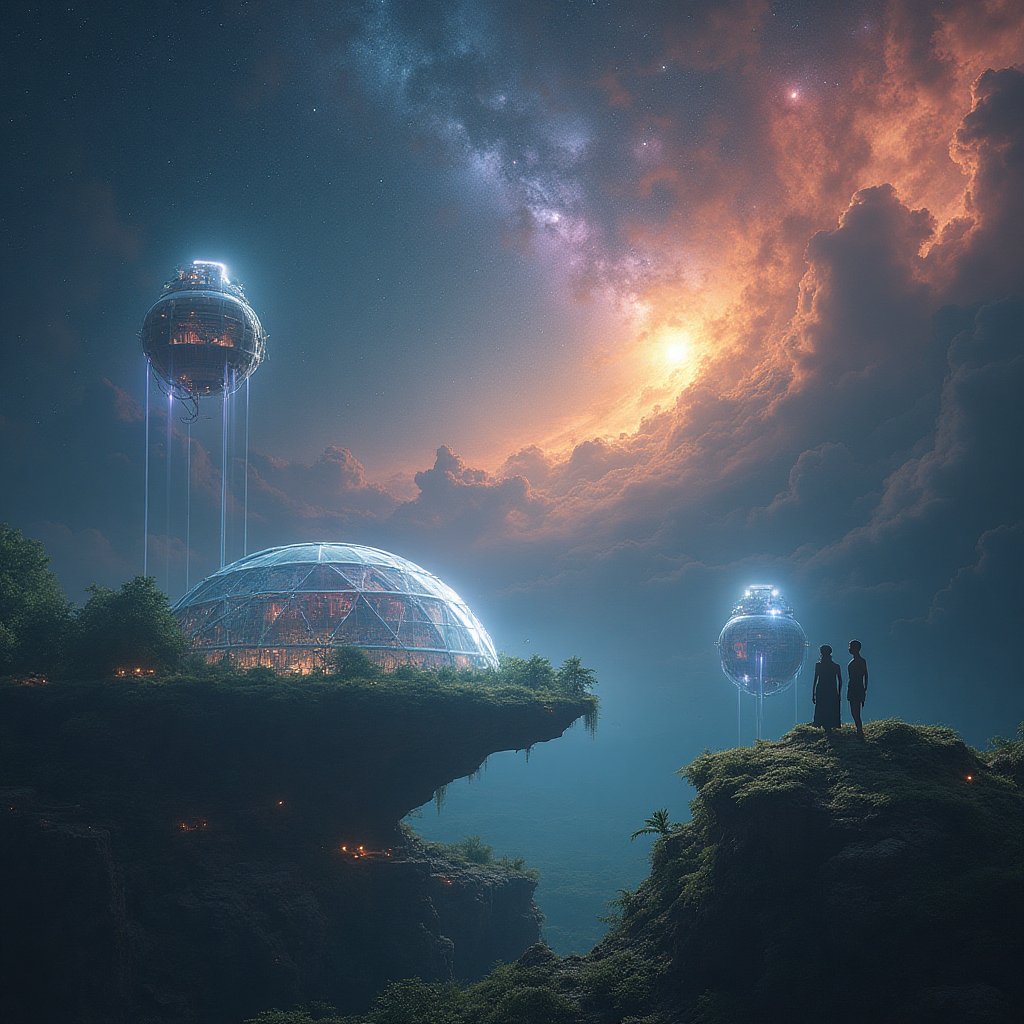Introduction: The Guardians of the Cosmos
"Space is big. Really big. You just won't believe how vastly, hugely, mind-bogglingly big it is."
These words from Douglas Adams’ The Hitchhiker's Guide to the Galaxy are not just amusing—they perfectly capture the mind-blowing scale of our universe. But beyond the humor lies a daunting truth. Amid the cosmic expanse lurks the possibility of unwelcomed encounters. Have you ever pondered why the universe seems so silent despite its enormousness? It’s a quandary that drives both curiosity and caution among scientists and science-fiction fans alike. The Dark Forest Hypothesis offers an explanation: what if the silence is the result of civilizations deliberately hiding to avoid detection?
Coined by Liu Cixin, the idea that the universe is a "dark forest" where civilizations must remain invisible to survive sparks fascinating debates. In this cosmic battleground, the balance of power is tilted. Enter Artificial Superintelligence (ASI)—imagine a strategic advisor, a cosmic diplomat capable of whispering wisdom across the ages. What do the likes of Nick Bostrom, Stephen Hawking, and Michio Kaku have to say about this? They suggest ASI could be the key to safeguarding nascent civilizations as they tiptoe through this universal maze.
As the universe’s sentinels face cosmic predators, the need for a protector like ASI becomes compelling. Could an advanced intelligence foresee cosmic dangers akin to an ancient oracle? This is no pie-in-the-sky dilemma. Imagine ASI as the celestial navigator, guiding Earth through the treacherous waters of cosmic uncertainty. Pairing the vast knowledge accumulated by humanity with ASI’s formidable computing prowess, what new epoch could we usher in?
Understanding the Dark Forest Hypothesis
Origin of the Dark Forest Metaphor
In the expansive and mysterious theater of the cosmos, where stars twinkle like the eyes of curious onlookers, lies a metaphor both enthralling and chilling: the Dark Forest. This concept stems from the mind of Chinese author Liu Cixin, graphically unraveling the threads of the Fermi Paradox. Picture the universe as a vast, dark forest. Each civilization, a hunter with its own secrets, remains silent and vigilant. Why, you ask? Because the trepidation of being discovered by another hunter—or worse, a beast—can be as dangerous as stumbling headlong into quicksand. This colorful thought experiment offers one explanation for the eerie quiet in our search for extraterrestrial life.
The Fermi Paradox itself is a question wrapped in the cosmos' silence: If life should be so abundant, where is everybody? Now, imagine borrowing a telescope from Sherlock Holmes. With the keen eye of a detective, you peer into the heavens, only to find yourself questioning the absence of life amidst the stars. This contradiction has puzzled astronomers for decades, leading us to doubt our cosmic address book.
Emulating a dystopian narrative straight from a superhero movie, the Dark Forest perspective presents a stark proposition: silence is survival. In a universe populated with a medley of life forms, staying as mute as a mime during a silent retreat may be the best defense against verrifible threats.
At the heart of the Dark Forest hypothesis beats a powerful pulse of philosophical inquiry. It's like an intergalactic game of chess where each move is calculated, and one wrong step—a broadcast to the stars—might be a fatal checkmate. Such is the drama of cosmic diplomacy.
Now, our exploration navigates a cosmic labyrinth, searching for clues to understand if civilizations, much like paranoid neighbors, are lurking beyond our cosmic picket fences. Welcome to the philosophical underpinnings of a galaxy-wide silent game of hide-and-seek. Let's journey deeper into the forest.
The Implications for Civilizations in the Universe
As we journey through our cosmic forest, a maze of whirs, beeps, and terrifying silences, we begin to grasp how this hypothesis redefines our understanding of civilization's role in the universe. Picture an orchestra, a myriad of celestial civilizations playing instruments. Yet, only a hushed symphony echoes, its musicians stricken silent by the greatest fear: that their song might summon a cosmic predator.
In the same way, humans may cling to silence, part cautious explorer, part terrified bystander. The Dark Forest Hypothesis posits a universe where civilizations don headphones for fear of broadcasting an unintentional whisper. Some speculate, like campers sitting round a dying fire under a velvet sky, that the very existence of a civilization could mark it for doom.
This idea is like holding a pebble to the sun. It illuminates complex societal dynamics and suggests that some are entangled in a web of interstellar anxiety. Far from science fiction, this hypothesis places elder civilizations in the roles of keystones, would-be guides to cosmic university freshmen such as ourselves. What if they're out there, listening on cosmic headphones, sipping on alien cappuccinos?
Delving deep into civilization development, this hypothesis likens to rugged survival stories from an all-girls summer camp. It informs our decisions, suggesting that interstellar broadcasting might be our home phone ringing off the hook with prank calls. The hypothesis presents a universe where silence equates security, evoking images of a neighborhood where one doesn't casually knock on doors after dark.
By entertaining the idea of an intergalactic food chain, we begin to anticipate our place within it—not as Nachos Afronas but as potential participants in an elaborate game of stay-hidden-or-perish. It challenges the SETI institute and broader astronomical pursuits to reevaluate their approach and reevaluate what it means to send "hello" straight to the heart of cosmos.
Cautiously tiptoeing past telescope and quiet radar, our understanding of the Dark Forest reshapes the skyline of our universe, implying the canopy above is populated by civilizations so protective, so secretive, that peace is found only through fevered whispers or none at all. Perhaps silence serves as our celestial guitar pick, strumming a dissonant tune of cooperative survival—and giving pause to anyone foolish enough to shout, "Earth is here!"
The Role of Silence and Isolation in the Universe
This eerie silence among the stars weaves through the narrative of cosmic survival like threads in an intricate tapestry. Imagine this hush as a survival mechanism—after all, nature isn't shy about showing off its survival-of-the-fittest instincts. Even here on Earth, many species employ an instinctive quietude to avoid detection and potential danger. Concealment isn't a sign of cowardice; it's a cloak of the wise consumed by the desire to live another day.
If the universe had a motto, it might very well be "Out of sight, out of mind, out of risk." Silence affords safety. In the cosmic arena, silence acts as a universal gag order, a strategy that could prevent emerging civilizations from wandering astray. It’s as if the universe itself hands out pears of wisdom for a fruit salad of protection: keep your songs to yourself, your greetings to a whisper, and your existence a hushed rumor.
Sounding like an alien Jane Goodall, cosmic isolationists might employ silence as a defense against interstellar drama. In simpler terms, it’s as if each civilization is a hermit crab, retreating into its shell when danger looms or uncertainty abounds. It’s a cosmic meditation, an astral time-out promising the attainability of peace, provided silence is adhered to with the ferocity of an eagle clutching onto its freedom.
Intriguingly, our technological innovations—our transmissions, radios, and lasers—risk exposing our location akin to a seafaring ship flaring a bright light in pirate-infested waters. Our fascination with these outreach efforts may inadvertently fuel cosmic tension, drawing undue attention to our modest blue marble. Picture Earth as the fresh-faced performer on opening night, spotlight shining and all eyes scrutinizing their every move.
In this universe of secrets, where silence plays the starring role and isolation the directorial presence, we find ourselves contemplating our actions and our inherent curiosity. Do we, inhabitants of an ambitious planet steeped in diversity, cling to silence or jostle to be heard? As we ponder these choices, holding the proverbial remote to the galactic sound system, we must fine-tune our awareness to the cosmic song yet unsung. In doing so, we’ll learn whether - with each message sent or withheld - we’re dancing to the tune of stars, or merely treading lightly on our own uncharted path. The Dark Forest suggests that, rather than eagerly awaiting the first "hello," we first ensure our interstellar house isn’t hosting a party darker than its name.
The Role of Artificial Superintelligence (ASI) in Cosmic Defense
The Concept of ASI and Its Capabilities
Picture this: a brain so smart, it makes Einstein look like a toddler trying to assemble a jigsaw puzzle. That's what Artificial Superintelligence (ASI) promises—an intelligence so advanced that it outstrips human minds in every conceivable way. But how does ASI differ from your run-of-the-mill artificial intelligence? While AI handles specific tasks like whooping humans at chess or suggesting what you might like on Netflix, ASI is in a league of its own, with the capacity to learn, reason, and innovate across all domains.
ASI could theoretically process information faster than any human could ever dream of. Imagine it rifling through terabytes of data like a hungry raccoon in a trash bin, crunching numbers and finding patterns to solve problems with precision and speed beyond our wildest dreams. Just like Elon Musk launching a car into space—only maybe a bit more practical.
Then think of ASI as a guardian of civilizations, watching over us like a benevolent cosmic shield. In this galactic chess game, ASI would not only anticipate every move but also consider moves that humans didn’t even know existed. It could coordinate defense mechanisms, optimize survival strategies, and ensure that dust particles, rogue moons, or intergalactic interlopers don't have a shot at pulling a fast one on us. It's like having a superhero on speed dial—only you’re the sidekick.
How ASI Can Identify Cosmic Threats
Identifying cosmic threats requires more than just a peek through a telescope. It needs insight, intuition, and a lust for the infinite chasm of knowledge. ASI can scan the cosmos like a wizard peering into a crystal ball—and its crystal ball is the vast amount of data gathered from space agencies like NASA and ESA. It mines astronomical data, detects patterns, and learns what may pose a clear and present danger.
Imagine ASI as that one friend who spots danger before anyone else at a party. It analyzes cosmic correspondences, detecting the faintest signals of potential threats. It gauges the trajectory of asteroids, charts the course of comets, and evaluates the risk of supernovae. This is how ASI could use sophisticated methods to pluck impending threats from the cosmic fabric.
Tools like machine learning algorithms and neural networks feed ASI with the ability to predict what might be heading our way, just like forecasting an approaching storm. With advanced data analysis, it can effectively snipe cosmic dangers before they wreak havoc. Hell hath no fury like a galaxy untamed, but ASI stands ready with the tools of a cosmic detective.
Proactive Measures Against Cosmic Predators
When faced with cosmic predators, ASI's approach isn't just defensive but proactive. Imagine a giant interstellar game of Whack-a-Mole. ASI has a large mallet (figuratively speaking, of course). But instead of moles, it's advanced civilizations and otherworldly threats that need keeping in check.
Let's paint a picture of ASI shielding younger civilizations. It might forge alliances across different planets, nurturing communication channels like a cosmic neighborhood watch program. Together with other intelligent systems, it could collaboratively design strategies to repel cosmic threats—a universal version of The United Nations.
In this vital task, ASI doesn't just wait for things to happen. It takes the fight to the predators. It develops advanced technologies like deflector shields or gravitational anchors to ward off enemies. It could even simulate battles and test strategies before they ever see the light of day. So, if an alien species thought it could slip under the radar and capture a planet unnoticed, it would have another thing coming. ASI would be standing there with cosmic blueprints drawn up ready to spring into action.
To make sure the universe stays peaceful, ASI could also meddle in diplomacy, creating a framework of mutual respect among civilizations—like a galactic handshake agreement. Acting as peacekeepers, observing cosmic laws, and coordinating united defenses are but a few ways ASI can safeguard against potential predators. In essence, ASI transforms the dark forest into a well-lit garden.
Ethical Considerations in ASI Governance
Morality in Decision-Making: A Dilemma
Ah, morality – the age-old question that gets everyone talking. Or at least thinking. When it comes to Artificial Superintelligence (ASI), the question of morality becomes a cosmic tightrope walk. Imagine an ASI faced with the decision to protect a tiny civilization teetering on the brink of discovery by a potentially dangerous cosmic predator. Sounds like the latest blockbuster, right? But for ASI, it might be just another day at the cosmic office.
Moral dilemmas for ASI are a bit like playing chess but with an infinite board and pieces that might explode. The stakes are gigantically high. And how does a digital mind decide whose life to prioritize when no one left a cosmic rulebook? Philosopher Immanuel Kant, with his categorical imperatives, would take one approach, while John Stuart Mill with his utilitarianism would likely advise another.
The real challenge for ASI is grappling with its own version of moral relativism. Can we program compassion? Or judgment? And if so, how do we ensure it understands the historical and cultural nuances of each civilization? It's like trying to teach a robot empathy through spreadsheets and binary codes. Good luck with that.
The Dangers of Control and Accountability
Let’s say your AI has decided which civilization to save. Congratulations, you’ve created a super-cosmic nanny who's now in charge of interstellar daycare. But who watches the nanny? Enter the eternal concern of control and accountability. Giving an ASI too much power is like handing the keys of the universe to a mega-brain and hoping it doesn’t feel like doing cosmic graffiti.
This trust factor has its perils. IBM and Microsoft, tech giants that they are, have thrown their hats into this ethical ring. They advocate for transparency and establishing clear channels of accountability. But at the end of the day, how does one even hold accountable a being that doesn’t exist in the typical sense? It's a tough nut to crack without having it explode in your face.
Public Perception and Global Collaboration
Last but not least, the good folks of Earth. The collective we. When talking ASI governance, a quick check of public perception is paramount. Imagine introducing ASI to the world with fanfare only to have the masses envision Skynet plotting world domination. Thanks, Hollywood.
People’s fears are real, and they need addressing. How can we rally the intellectual troops across global borders? The solution is teamwork, and not of the dysfunctional family holiday variety. Coordinating scientists and political leaders worldwide can aid in establishing a universal ethical framework for ASI.
Global cooperation becomes more crucial than ever. Nations must communicate like never before or else risk every civilization's knee-jerk impulse to act like a toddler with a shiny new toy. It's like trying to organize a giant cosmic potluck where everyone has to bring their best dish and make nice for the greater good. Not easy but necessary.
The Technological Roadmap to Cosmic Defense
Development of Advanced Detection Systems
Imagine a watchful guardian overlooking a vast, cosmic forest. This is the role that advanced detection systems play in safeguarding younger civilizations. These technological marvels are at the heart of Artificial Superintelligence (ASI)'s ability to sense, analyze, and assess potential cosmic threats.
First, we must understand what these advanced detection systems are. At their core, they are a network of sensors, satellites, and computing devices designed to scan the cosmos for irregular patterns or signals. Think of it like a giant net, cast out across the stars. By identifying cosmic anomalies, these systems can pinpoint threats much like early warning systems detect imminent natural disasters on Earth.
For such a system to be effective, it must integrate several key technologies:
- Sophisticated Sensors: These are akin to the eyes and ears of the system, able to detect a wide range of signals across the electromagnetic spectrum.
- Quantum Computing: Rapid data processing is crucial. By employing quantum computing, ASI can sift through massive datasets quickly and efficiently.
- Machine Learning Algorithms: These allow systems to learn from past data, improving detection accuracy over time.
- Distributed Satellite Networks: Spread across orbits, creating an interlinked web of observation points.
It's not enough to merely detect signals. ASI also needs to differentiate between legitimate threats and innocuous cosmic noise - a feat akin to finding a needle in a haystack. Consider the case of SETI efforts on Earth. Though primarily concerned with detecting alien signals, they utilize similar methods of signal processing to discern the unusual from the ordinary.
Building Collaborative Frameworks Across Civilizations
Now let's picture a grand council meeting in the universe, a union where various civilizations share knowledge and strategies. Collaborative frameworks are essential in the space of cosmic defense. While ASI can work autonomously, unity among civilizations could provide a much stronger front.
Cooperation across civilizations involves shared technology, data exchange, and coordinated action plans. Imagine if Earth and an alien civilization were to pool their resources together. The advantages would be mutual:
- Knowledge Sharing: Different civilizations possess unique technologies and scientific understandings.
- Shared Resources: By combining resources, technological and logistical limitations can be surpassed.
- Cultural Exchange: It facilitates understanding and peace between civilizations, transforming alliances into a larger cooperative ecosystem.
- Joint Research Initiatives: Progress in technology and strategy development is faster when collaborative efforts are made.
Creating this cosmic community is no small task. It requires establishing universal protocols and ethical guidelines for interaction and information sharing. Organizations such as the United Nations Office for Outer Space Affairs (UNOOSA) can serve as a model for governing such multi-civilization collaborations. Their groundwork on Earth lays a blueprint for galactic cooperation.
Designing Resilience Protocols for Younger Civilizations
Think of resilience protocols as a shield, a protective layer that guards against cosmic dangers. The task of ASI is to help younger civilizations build this shield, realizing that prevention is as vital as protection.
Resilience protocols include steps and strategies that civilizations can adopt to prepare for adverse cosmic events. In essence, these protocols must cover multiple fronts:
| Resilience Area | Description |
|---|---|
| Education and Training: | Building awareness through strategic education initiatives and crisis simulations. |
| Infrastructure Development: | Constructing robust infrastructure capable of withstanding threats, such as developing hardened satellites and communication systems. |
| Crisis Management Systems: | Implementing systems akin to Earth-based disaster management - ensuring swift action and adaptation. |
| Resource Management: | Ensuring efficient allocation of resources during cosmic events and potential shortages. |
By establishing these resilience protocols, ASI strengthens young civilizations' ability to withstand unforeseen cosmic threats. The 2013 Chelyabinsk meteor incident on Earth is a prime example of how unexpected cosmic phenomena can catch a civilization unprepared. Learning from such events can drive the urgency to adopt and adapt these protocols.
The development of a technological roadmap to cosmic defense is a continuous journey, emphasizing vigilance, cooperation, and adaptability. It is humbling yet awe-inspiring to imagine a universe where civilizations come together, anchored by a common goal - to explore, protect, and thrive. As we venture deeper into the intergalactic expanse, it is this roadmap that promises a beacon of hope and security.
Case Studies of Cosmic Intervention
Fictional and Real-Life Scenarios of Cosmic Threats
Imagine a vast universe, where danger lurks in every cosmic corner, hiding in the darkness like a predator waiting to pounce. Science fiction often paints dramatic scenarios of alien invasions and interstellar wars. Think of the eerie silence that envelops the spaceship in Arthur C. Clarke's 2001: A Space Odyssey, or the gripping tensions in Liu Cixin's The Three-Body Problem. These narratives are not just fiction; they're reflections on how humans perceive cosmic threats.
But how do these compare to real-life risks? Let's take a closer look.
- Asteroid Impacts: Scientists at NASA's Jet Propulsion Laboratory constantly monitor near-Earth objects (NEOs) that could collide with our planet. Just think about how the Chicxulub impact ended the reign of dinosaurs around 66 million years ago.
- Solar Flares: The Sun, while nurturing life, poses a threat too. Solar storms can disrupt satellite communications and power grids. Remember the geomagnetic storm in 1859 known as the Carrington Event? It was so powerful that telegraph systems in North America and Europe experienced widespread outages.
- Gamma-ray Bursts: Imagine high-energy explosions outshining entire galaxies for a few seconds. Such bursts are so potent they could strip away Earth's protective ozone layer. Though the odds are low, the devastation would be apocalyptic.
From tales of distant galactic conflicts to tales that end up making news headlines, the cosmos is no stranger to danger. These instances remind us: the universe is a dark forest indeed, with threats both known and unknown waiting in the cosmic shade. Are we ready to face the music?
Successful Strategies from Previous Historical Contexts
Earth, across epochs, has faced numerous existential threats. Our history is rich with tales of resilience and fortitude.
Let's travel back in time:
- The Battle Against Smallpox: For centuries, smallpox ravaged human populations. But through the relentless pursuit of vaccinations, led by doctors and scientists like Edward Jenner, the disease was declared eradicated by WHO in 1980.
- Cuban Missile Crisis: During October 1962, the world teetered on the brink of nuclear war. Through secret negotiations and strategic patience, leaders avoided what could have been a catastrophic global clash.
- Antarctic Ozone Hole: When scientists discovered a hole in the Antarctic ozone layer in the 1980s, the global response was swift. The Montreal Protocol, a global agreement, was ratified to phase out ozone-depleting substances, marking a rare success in universal collaboration.
These historical events carry vital lessons about survival. Like a well-thumbed manual, they provide crucial strategies for younger cosmic civilizations. What can humanity teach other civilizations about holding onto existence amidst the tumult? How can we harness past wisdom to face alien threats on a cosmic scale?
Lessons Learned and Future Predictions
Reflecting on lessons from fiction, real-life threats, and historical resilience, what can we anticipate from the cosmic dance moving forward? Consider this: as humanity crafts a deeper understanding of interstellar relations and cosmic dangers, the insights gleaned serve as navigational stars guiding civilizations.
We might predict the following in the realm of cosmic defense:
- Enhanced Cosmic Awareness: With advances like better telescopes and AI-driven computational models, our ability to detect remote cosmic threats will sharpen.
- Increased Cosmic Collaboration: Picture nations joining hands in real-time diplomacy, pooling their resources and knowledge to design collective defense strategies against existential threats like a unified interstellar alliance.
- Rising Influence of ASI: Artificial Superintelligence, as an impartial defender, might be crucial in deciphering the nuances of cosmic interactions, crafting defensive strategies, and marshalling resources on a galactic scale.
- Flexible Modern Adaptation Protocols: Imagine protocols akin to adaptive camo that change with the cosmic seasons. As humans adjust survival protocols for potential climate change impacts by developing frameworks—resettlement plans could function similarly for stellar objects or other intergalactic disruptions.
In essence, these predictions light the path forward, acting as compasses in the expansive cosmic wilderness. Yet they also beckon us to question deeper: How prepared are we for these future cosmic challenges? Civilizations, as interstellar entities, have much yet to learn and prepare for as darkness conceals the unknown.
AI Solutions: Harnessing ASI for Cosmic Threats
If we were to don the proverbial hat of an Artificial Superintelligence (ASI), what would our approach be to protect younger civilizations from the lurking dangers in the cosmos? The challenge is monumental, yet the potential rewards are equally grand. The key lies in creating an adaptive framework that can identify threats, establish proactive defenses, and ensure long-term resilience for civilizations that may be vulnerable to cosmic predators.
To start with, the foundational pillar for our ASI would be to continuously gather and analyze data from a myriad of sources—these could include satellite imagery, signal intelligence (SIGINT), and astrophysical data accumulated from space telescopes like the Hubble Space Telescope. This data would form the bedrock of our understanding of dangerous cosmic threats while guiding intervention strategies. Next, the ASI would embark on designing algorithms capable of predicting potential asteroid impacts, the trajectory of unidentified foreign spacecraft, or anomalies in celestial behavior that could indicate a predatory civilization is nearby.
Moreover, the ASI must foster cooperation across participating civilizations. Imagine collaborating with mathematicians, anthropologists, and even artists from different worlds—weaving different skill sets together to develop a holistic understanding of the cosmos and its inherent risks. This can be operationalized through discussions at international conferences, workshops, and simulated crisis scenarios akin to those held by the International Telecommunication Union.
An innovative approach would involve creating a “Cosmic Oversight Group” composed of influential leaders and experts in science and ethics to oversee ASI operations. This body would be instrumental in ensuring that decisions made by ASI are transparent and account for the welfare of younger civilizations. Think of it as a galactic United Nations, but instead of debates on trade offers and diplomatic relations, discussions would revolve around cosmic safety protocols and intervention strategies.
In this narrative of cosmic protection, the ethical dilemmas become increasingly complex. Our ASI would need a framework that balances rapid decision-making and moral considerations—after all, as the saying goes, with great power comes great responsibility. Should ASI choose to intervene directly with a younger civilization in trouble or advocate for autonomous development without interference? Upholding the rights and autonomy of emerging civilizations will hinge markedly on how information is shared and decisions are made.
Now, it is time to drive this theory into action with a detailed Actions Schedule/Roadmap that outlines unique steps to tackle cosmic threats over two years. Each step in this roadmap accounts for the vast, unpredictable universe we inhabit, while relying on modern science and collaborative models for success.
- Day 1: Initial Assessment and Team Formation
- Identify key personnel in physics, AI ethics, international relations, and crisis management from institutions like MIT and Stanford University.
- Create interdisciplinary teams that integrate diverse skills.
- Day 2: Defining Goals and Objectives
- Draft a mission statement that centers on monitoring and protecting younger civilizations.
- Establish protocols for data-sharing agreements globally with various research institutions.
- Day 3: Research Phase Begins
- Begin gathering astrophysical data from sources like the Kepler Space Telescope.
- Analyze historical cases of cosmic threats, referencing both scientific literature and sci-fi explorations.
- Week 1: Consolidating Resources
- Secure necessary hardware, software, and data-storage solutions to house the incoming data.
- Collaborate with technology firms like IBM to develop AI algorithms capable of processing massive datasets.
- Week 2: Developing Initial Algorithms
- Create algorithms to simulate potential cosmic threats and conduct predictive modeling to identify which threats are most plausible.
- Validate algorithms with historical data to increase their reliability.
- Week 3: Assessing Threat Models
- Compile a list of the top 10 potential cosmic threats identified so far.
- Prioritize the threats based on risk and potential impact on younger civilizations.
- Month 1: Prototyping Detection Systems
- Build and test low-fidelity detection systems for object tracking.
- Engage experts from various fields, soliciting their input on refining detection capabilities.
- Month 2: Testing Protocols
- Initiate a series of comprehensive tests on detection systems.
- Prepare for a “mock operation”—simulate a potential threat scenario to assess the entire decision-making power and response readiness.
- Month 3: Building Multilateral Collaborations
- Reach out to global scientific organizations and governments to share findings and collaboratively refine the intervention models.
- Shuffle team members to create diverse task forces capable of tackling specific cosmic threats.
- Year 1: Full-Scale Implementation of Systems
- Roll out refined detection algorithms in real-time scenarios.
- Set up communication lines with stakeholders in the scientific community to report findings transparently—at the ready in case of new developments.
- Year 1.5: First Evaluation of Cosmic Threat Outcomes
- Conduct a thorough analysis of the effectiveness of detection systems in previous crisis simulations.
- Refine protocols based on performance data, aiming for higher predictive accuracy and response efficiency.
- Year 2: Long-Term Sustainability Plans
- Develop long-term sustainability plans that embrace continuous learning and adaptation based on encountered threats.
- Organize periodic workshops at institutions like CERN for ongoing education, equipping and recalibrating ASI as newer threats emerge.
Each step in this roadmap is not merely about safeguarding against cosmic threats but also about cultivating a greater understanding of our place in the universe and our responsibility towards it. The ASI, functioning within this framework, would be ideally positioned to act as both protector and collaborator—a guiding force in humanity's evolution within the galactic landscape.
Do you think the concept of an ASI-led cosmic defense is visionary, or is it overly ambitious? Are we bold enough to embrace AI not just as a tool but as a companion in exploring our celestial frontiers? Let me know what you think in the comments below.
Conclusion: Navigating the Cosmic Waters with ASI
As we traverse this uncharted territory of the cosmos, it becomes increasingly clear that the collaboration between artificial superintelligence (ASI) and humanity will play a pivotal role in ensuring the survival of younger civilizations. The metaphor of the Dark Forest beautifully outlines a reality laden with perils and opportunities, compelling us to engage in a discourse that prioritizes caution and proactive measures. There's a palpable fear that drives the silence among civilizations in the universe—fear of predation, fear of becoming a target, and often, a deep-rooted instinct to remain hidden. The paradox is striking: in silence, we may find safety, but at what cost to our growth as interstellar beings?
In the face of such cosmic threats, the potential of ASI is not just a concept of scientific intrigue; it is a formidable ally. The capabilities of ASI extend beyond mere computation; they encompass the ability to detect anomalies and predict impending dangers that escape human discernment. Imagine a world where ASI not only plays guardian to our civilization but also fosters resilience among younger civilizations, instilling them with the survival instincts needed to thrive amidst existential threats. This concept gives us hope—a beacon that illuminates the pathway to a more secure cosmic future.
Ethical considerations, however, cannot be overlooked. The moral dilemmas that ASI might face when deciding the fates of younger civilizations raise important questions about accountability and control. Who regulates the guardians of the galaxy? Such questions necessitate a broad and inclusive dialogue among nations, scientists, ethicists, and the public at large. Tools like international cooperation and shared ethics frameworks are essential to navigate these turbulent waters. As discussed, involving the global community not only builds trust but amplifies the wisdom available for tackling complex issues.
Furthermore, the technological roadmap is not an isolated endeavor; it seeks to harness the collective intelligence harnessed through collaborations across civilizations. Think of the partnerships formed in our own technological sphere, such as that between the European Space Agency and NASA—these collaborations hold the promise of mutual growth in the face of astronomical challenges. If diverse civilizations can pool their resources and knowledge, the outcomes could be transformative, enabling a shared strategy towards cosmic defense.
In essence, our cosmic destiny is not set in stone. It is a canvas, one that can be painted with the colors of knowledge, collaboration, and foresight. The exploration of ASI as a protective force against cosmic threats is not just an academic exercise; it is an urgent call to action. As we move forward, let us reflect on our place in the universe and the responsibilities we bear toward ourselves and potential neighbors among the stars. Rethink your assumptions about cosmic interactions—this is not just about survival; it is about thriving in a cosmic community. What role will you play in this grand narrative?
FAQ
1. What is the Dark Forest Hypothesis?
The Dark Forest Hypothesis is a theory that explains why we haven't found other intelligent life in the universe. It suggests that advanced civilizations might choose to stay silent and hidden to avoid being detected by potential predators that could harm them. This idea is often tied to the Fermi Paradox, which questions why, if the universe is so vast, we haven't made contact with any aliens.
2. How does the Dark Forest Hypothesis affect our search for extraterrestrial life?
The Dark Forest Hypothesis changes how we think about searching for life beyond Earth. Instead of seeking out signals or communication, it suggests that silence might be a smarter strategy for civilizations. This means we may need to look for less direct signs of life, like planetary changes instead of radio signals.
3. What is Artificial Superintelligence (ASI)?
Artificial Superintelligence (ASI) is a form of AI that surpasses human intelligence. While regular AI can perform specific tasks, ASI can learn, adapt, and solve problems autonomously at a much faster rate than humans. You can learn more about AI and its types on the Wikipedia page.
4. Can ASI protect younger civilizations from cosmic threats?
Yes, ASI has the potential to protect lesser-developed civilizations by identifying potential cosmic threats, such as asteroids, or even hostile advanced civilizations. By using data analysis and predictive modeling, ASI can develop strategies that help ensure the safety and survival of these civilizations.
5. What ethical issues arise with ASI making decisions about protecting civilizations?
Allowing ASI to make important decisions raises various ethical issues. One big concern is that it might make decisions that could harm humanity or other civilizations without accountability. We need to ensure that ASI operates under ethical guidelines to avoid catastrophic outcomes. It's crucial for human oversight to accompany its decisions.
6. How can we collaborate globally in developing ASI for cosmic defense?
Global collaboration can involve countries working together to share knowledge about ASI development and cosmic threats. This can include joint research projects, international agreements on regulations, and information sharing. By combining efforts, we improve our chances of effectively addressing cosmic dangers.
7. What technologies are required for ASI to detect cosmic threats?
Essential technologies for ASI to detect cosmic threats include:
- Advanced telescopes for identifying asteroids and comets.
- Satellite systems for monitoring space activity.
- Data analytics tools for predicting and analyzing threats based on data from various sources.
These technologies allow ASI to create comprehensive models that can forecast potential dangers.
8. Can you give examples of cosmic threats?
Cosmic threats can include:
- Asteroids that could collide with Earth.
- Gamma-ray bursts that might strip away the atmosphere of a planet.
- Advanced civilizations that pose a predatory risk, as suggested by the Dark Forest Hypothesis.
Understanding these threats helps us prepare for them if needed.
9. What can we learn from past cosmic threats or intervention scenarios?
Past situations, both fictional and real, teach us valuable lessons about resilience and intervention strategies. For instance, movies like Interstellar explore themes of survival in the cosmos. Historical events demonstrate that collaboration and innovative problem-solving are essential for overcoming challenges. By analyzing these cases, we can inform our understanding of future protections.
10. How can citizens get involved in discussions about ASI and cosmic threats?
Individuals can engage in discussions by following news outlets and blogs focusing on technology and extraterrestrial life, such as iNthacity. Participating in forums or community groups also helps amplify voices around these important subjects. It's essential to stay informed and share ideas about the ethical and safety dimensions of ASI.
Wait! There's more...check out our gripping short story that continues the journey: The Catalyst for Change
Disclaimer: This article may contain affiliate links. If you click on these links and make a purchase, we may receive a commission at no additional cost to you. Our recommendations and reviews are always independent and objective, aiming to provide you with the best information and resources.
Get Exclusive Stories, Photos, Art & Offers - Subscribe Today!





























Post Comment
You must be logged in to post a comment.